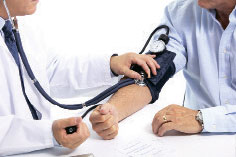
It can be caused by forgetting to take certain medication or the body failing to respond to usual doses of medication, by situations of extreme stress, changes in the weather, too much coffee or alcohol, overeating, hormone disruption, or the use of some medicines.
Various levels of severity are possible. Light distress may be caused by a stressful situation (without prior symptoms and lasting anything from a few minutes to 2-3 hours). Such a crisis tends to begin suddenly, despite usual good health, marked by a sharp, pulsing headache, blurred or double vision or, even, temporary loss of sight. Such symptoms bring about excitement, irritation or extreme concern. It’s common to experience warmth and dryness in the mouth, coldness in extremities and shivering all over. There may also be a feeling of the heart racing, as well as stabbing pains in the heart, and shortness of breath. Patients may display a red face, neck or hands, or they may become pale, with red patches — especially on the chest. Body temperature raises a little (usually no more than one degree) but perspiration increases.
If signs appear for the first time, consult a doctor immediately or call an ambulance. Usually, no medical aid is necessary but the ‘crisis’ may indicate longer-term illness. Keep the patient calm, since panic may exacerbate their condition. Offer a tincture of valeriana or leonurus and ensure that fresh air is available: open a window or ventilator. The patient may be put to bed but slightly propped up. Keep them warm and allow them to rest. An ice pack or cold compress may be applied to the head, while mustard plasters can be attached to the calves or the back of the head. Similarly, warm hot-water bottles may be placed on the feet and shins (for 15-20 minutes).
If medicine is prescribed, ensure it is taken: one tablet of nitroglycerine under the tongue (and call an ambulance). While waiting, take another tablet if needed, but no more than two, to avoid a dangerous drop in blood pressure.
Doctors recommend known sufferers keeping to hand antihypertensive preparations, such as captopril (capoten — 25mg dose) or nifedipine (corinfar or cordaflex — 10mg dose). Discuss their use with your doctor. If there is no change within half an hour, take another, identical, dose, but no more! If another 30 minutes passes without the patient returning to their normal state, call a doctor.
Measure blood pressure every 20 minutes, to monitor recovery rate; if the condition of the patient stays the same or worsens, or if they experience chest pain or any other alarming symptoms, call an ambulance immediately.
In certain cases, the ‘crisis’ can be treated by intravenous or intramuscular preparations, administered by a doctor. If the case is complicated, and occurring for the first time, urgent hospitalisation is required, which patients should not refuse.
To avoid dangerous complications, a patient should monitor their blood pressure closely, recording the results in a special diary. Moreover, they should not forget to take any prescribed medication, since even a single omission can lead to a sharp increase in blood pressure, causing serious complications: cardiac infarction or stroke.
By Tatiana Zhukova
Doctor of higher category, M.D. Ph.D.
Doctor of higher category, M.D. Ph.D.












